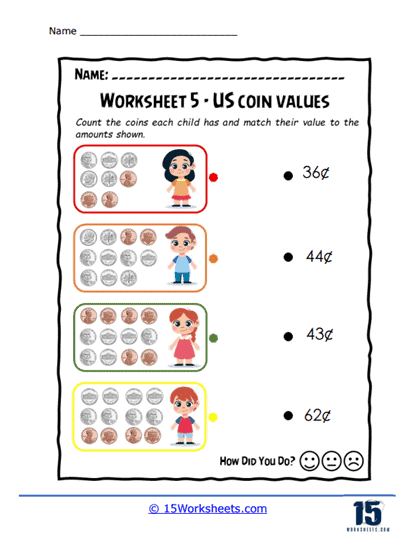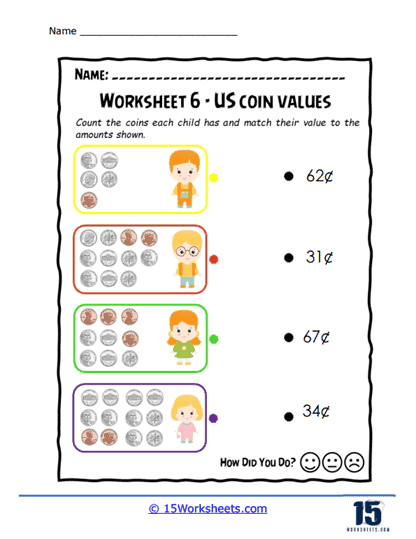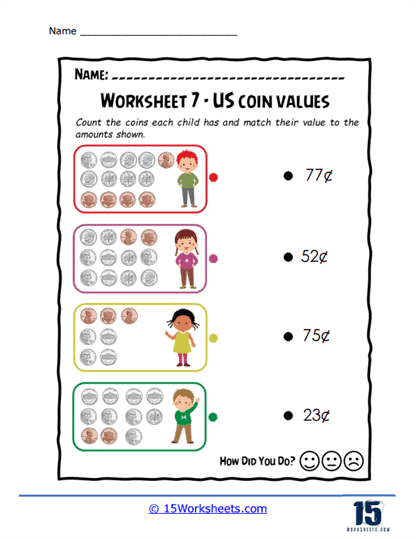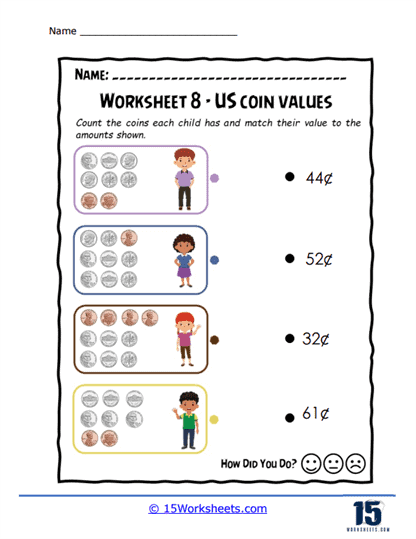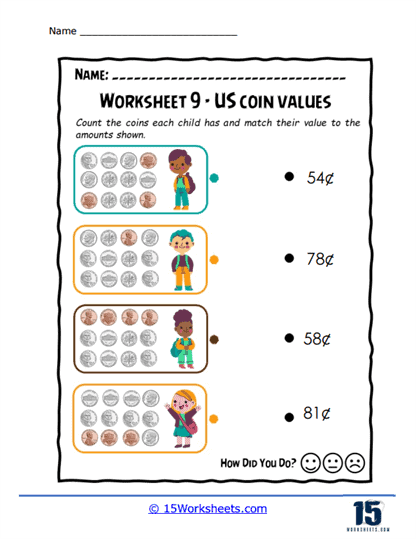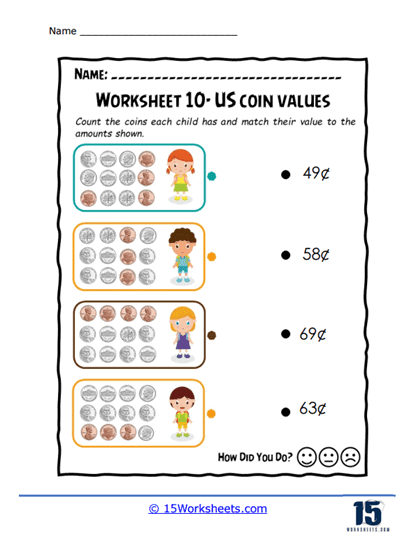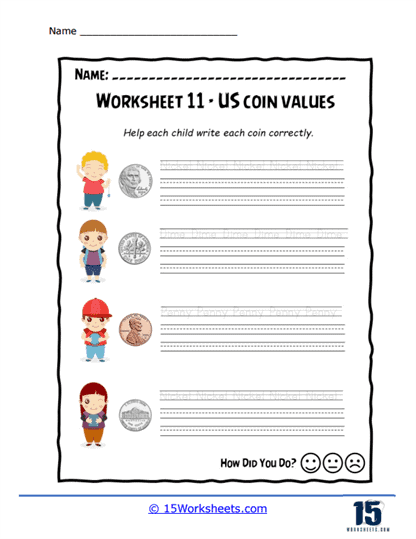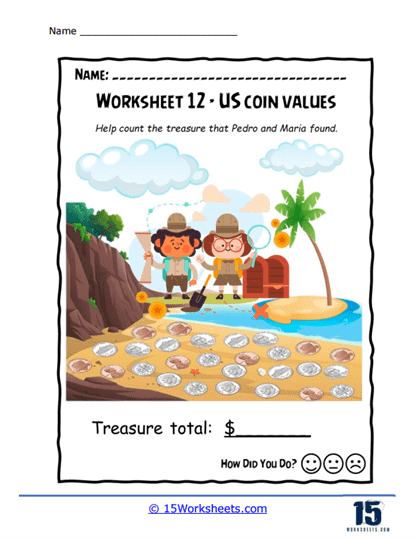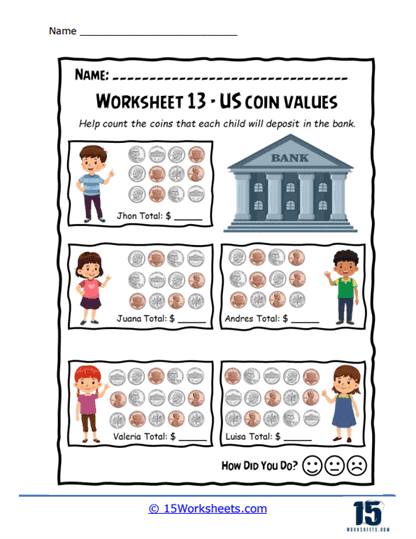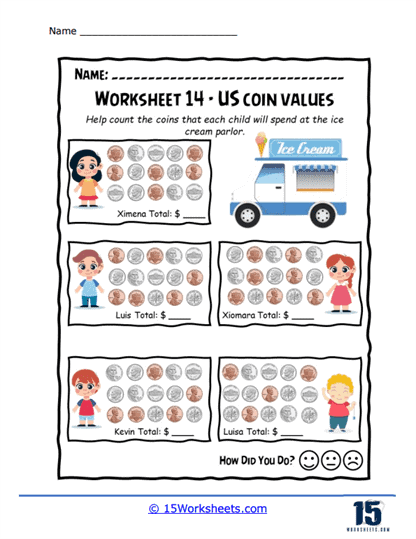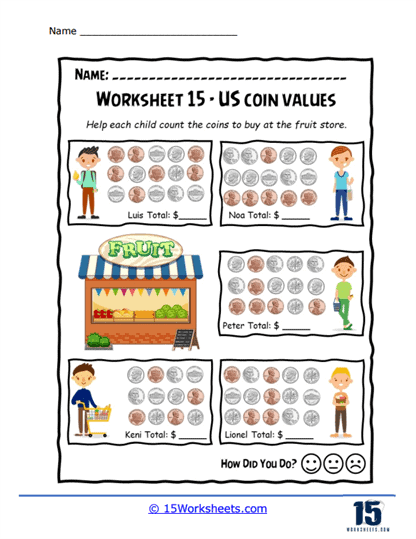Coin Values Worksheets
About These 15 Worksheets
Coin Values Worksheets are instructional tools used to educate students on the value of different coins used in currency. These worksheets serve as a foundation for financial literacy, teaching the basics of coin recognition, addition, and arithmetic using real-world examples. They are particularly useful in helping young learners become comfortable with money, understanding its worth, and applying simple math operations to accumulate and compare values.
Through a variety of exercises, they engage students with hands-on learning that applies directly to real-life scenarios, ensuring that the concepts of currency and its value are not only understood but also retained and utilized. These worksheets not only teach children about money – they prepare them for a world where financial knowledge is synonymous with personal empowerment and success.
There are several types of exercises that you might find on Coin Values Worksheets:
Recognition and Naming – The simplest type of exercise on these worksheets is coin recognition and naming. Students are shown images of coins and asked to write the name and value of each coin. This helps learners to distinguish between coins, which is fundamental in understanding their respective values. Involving more advanced reading and comprehension skills, word problems ask students to solve a problem involving coin values, such as figuring out the total value of coins saved in a piggy bank.
Sorting and Matching – These exercises involve sorting coins into groups based on their value and sometimes matching them to items with equivalent costs. This teaches students how to categorize coins and understand their cumulative value. This involves counting coins in groups of twos, fives, tens, etc., which is practical for quickly determining value without counting each coin individually.
Simple Addition – These exercises present students with groups of coins and ask them to calculate the total value. It’s a straightforward way to practice addition using tangible, everyday objects like money. In these exercises, students might be given a price for an item and an amount paid, and they must determine the correct change in coins. This type of exercise is practical and simulates real-life shopping experiences. Beyond simple addition, some worksheets require students to subtract one group of coins from another, teaching them the basics of subtraction using money.
Comparing Values – Students are given two sets of coins and must determine which set has a higher or lower value, or if they are equal. This strengthens their ability to evaluate and compare different sums of money. These worksheets ask students to show different ways to make the same amount using various coins. For example, how many different ways can you make 50 cents?
Rounding and Estimating – Some exercises challenge students to round coin values to the nearest ten cents or dollar, which is a helpful skill in estimating costs and making quick mental calculations.
The Benefits of These Worksheets
The utilization of these worksheets brings a multitude of benefits, enhancing students’ mastery of both basic currency and applicable math skills. These worksheets serve as a practical platform for reinforcing numeracy, where the tactile experience of handling coins and computing their total worth ingrains essential mathematical operations like counting, addition, and subtraction. Through consistent practice, students not only learn to recognize the value of each coin but also to manage money adeptly, a skill that remains pertinent throughout life. Such exercises extend beyond mere calculations; they embody the practical usage of mathematics in day-to-day activities including making purchases, saving for future needs, and crafting a budget.
These worksheets are instrumental in honing problem-solving abilities. Students encounter various hypothetical yet realistic scenarios where they must navigate through financial challenges using logical reasoning and mathematical principles. This nurtures a keen eye for detail, as precision is paramount when dealing with financial transactions; students become meticulous in noting the differences in coin values and ensuring their sums are accurate. This precision, in turn, cultivates confidence in young learners, diminishing any trepidation associated with monetary exchanges and fostering a sense of self-assurance in their ability to handle fiscal matters.
Looking ahead, the knowledge gained from these worksheets lays a solid foundation for more intricate aspects of financial literacy. Understanding the basics of coin values paves the way for grappling with more complex economic concepts such as interest rates, investment returns, and the principles of budgeting. Such preparatory learning fosters independence in students, enabling them to navigate simple financial tasks with ease and confidence, which is crucial for making informed decisions about purchases and money management, even at a young age.
These worksheets also contribute significantly to cognitive development, challenging the brain’s capacity for memory, enhancing the recognition of patterns, and improving sorting skills. These cognitive skills, developed through the context of financial learning, are versatile and can be applied across various learning domains. Additionally, by engaging with Coin Values Worksheets, students begin to grasp the importance of savings. They witness firsthand how incremental savings can grow over time, an invaluable lesson in the power of financial foresight and patience.
These worksheets are not just about learning to count money; they are a gateway to a comprehensive suite of life skills. They impart a solid understanding of the basics of currency, instill a sense of fiscal responsibility, and inspire a confident, independent approach to personal finance that young students will carry into adulthood.





